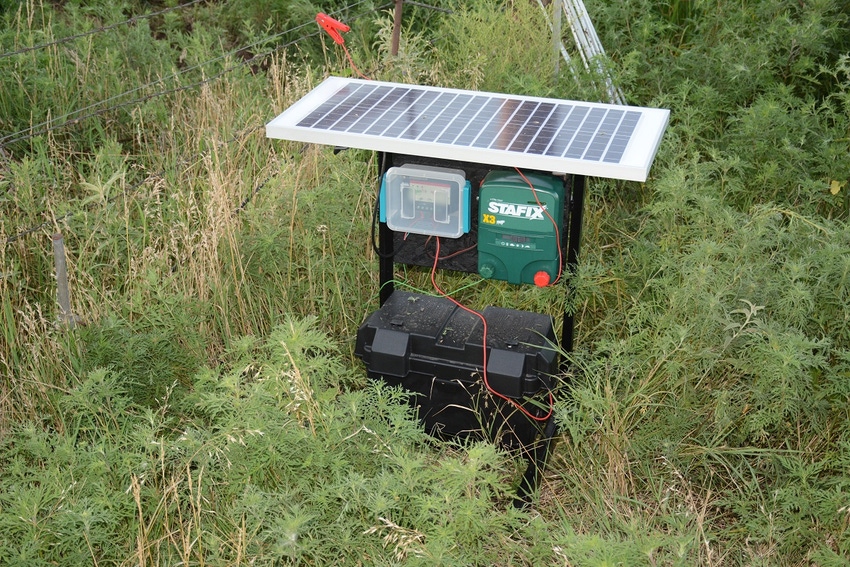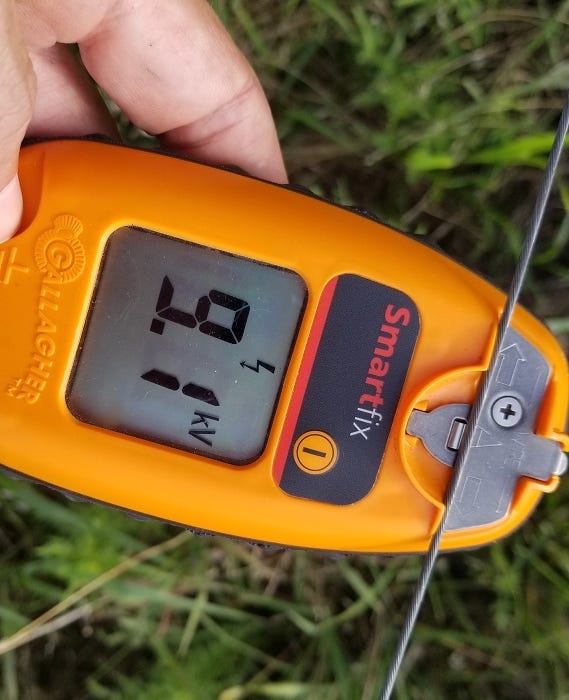
If you need to control stock on a property that has no electricity, the best option is to buy or build a good solar-charged, battery-powered energizer.
We're not talking about the little all-in-one solar energizers commonly designed for backyards or small areas like hay yards. We're talking about serious low-impedance energizers with at least two joules of energy.
I found myself in this situation recently. I got a lease on a quarter-section of grass with no electricity and no piped water. Since I'm not the owner, I'm not interested in spending money to run electricity.
The simplest solution is to buy one of the prepared kits such as you might find from American Grazinglands Supply, but purchasing that labor and know-how from someone else will cost you $200-300 per unit, or possibly more. I spent $360 on my unit, not counting the scrap metal I always keep around. Also, deep-cycle batteries are not included in my price or other prices.
If you're interested in building units like this on your own, here are the basic parts you need and the foundations for the knowledge you'll need.
Here's your list:
Battery-capable energizer
12-volt deep-cycle battery
Solar panel
Solar charge controller
Mounting hardware
Ground system
Which energizer?
Many energizers today are designed to run on either AC or battery power.
Within reason, bigger is always better, a little like more ground rods and therefore a bigger earth field is always better within reason. On the other hand, you can spend yourself into the poor house on an energizer, just like anything else. My old Speedrite 580 is supposed to have a 5.8 joule output, and has very effectively run several more miles of fence than I am now operating. I figured I could get by with less output. So far it is controlling stock just fine.
After studying energizer manufacturer's claims, which are only claims, and talking to Ted Alexander in Kansas who with son Brian have run several thousand acres for many years on solar energizers, I decided I could live with a 3-joule output. If needed, I can set up another ground system across the quarter and move it when the cattle are farther away. However, I don't think I'll need to. I'm mostly powering external line fence and only a few temporary interior fences at once. Very little electric fence infrastructure.
If you're unsure, call and talk to several of the manufacturers about your needs.
What solar panel?
Although solar panel manufacturers say there are now three types of panels, you'll actually be choosing between two solar panel types.
The old standby is the monocrystalline panel. The polycrystalline panel is the new kid on the block, and slightly cheaper to manufacture and apparently to sell. This webpage has a pretty extensive explanation of the differences. Keep in mind that much of what you'll read is aimed at larger users of solar panels, such as people powering at least part of their homes or their RVs.
As for the size/wattage of the panel, some energizer manufacturers list recommendations with their units, but I didn't find much of that. Kencove fencing offers a page with good calculations and guidelines. It says the general rule is 10 watts of solar panel per joule of output energy. Note this is output energy, not stored energy. I chose a 30-watt polycrystalline panel. If you live where the sun doesn't shine as often as it does here in the southern Great Plains, that should be another consideration for you. The Kencove solar page offers a map with peak hours of sunshine that may be helpful to you.
Solar charge controller
The solar charge controller works more or less like a voltage regulator in your car or truck to prevent overcharging and thereby shortening the life of your deep-cycle battery by the solar panel. At night, it may also prevent the panel from sometimes draining a little bit of battery power, which seems to be a minor issue.
I found two articles that helped me understand types of charge controllers, plus how and why they work. Again keep in mind these are aimed more toward large systems in many references.
Many of the medium-sized models seem to be Pulse-Width Modulation (PWM) models, which pulses little shots of energy into the battery when it's nearly full as you might use drips of water from a faucet to keep a leaky container full as it sat leaking into the sink drain. This is probably what you'll use.
I bought a 10-amp PWM model, which is rated for up to 100-watt panels. It seems to be in pretty common use by those who manufacture solar energizer setups as kits. It comes in a waterproof model, which I certainly would prefer if I were to buy it again. I missed that option for only $5 more when I ordered it, so I enclosed mine in a snap-top food container for the time being. I am a little concerned about its ability to dissipate heat but so far it is working fine.
Mounting hardware and more
I wanted my unit to be moveable to alternate locations, so I built a small frame to hold all in one. The battery in its box sits in the bottom, providing a tremendous weight and counterbalance. The upright frame is only 24 inches tall, with a piece of painted OSB (oriented strand board) as the mounting plate for the energizer and charge controller. The solar panel mounts on top with two swivel points that lock in place with 5/16-inch bolts and lock washers. This way I can swivel it slightly southward in the winter, if needed.
Adequate ground system
This is the same for all fence energizers, but I included it in the list because people always want to cheat on the ground system (aka earth system).
Don't. The energy pumping out from the positive side of the energizer cannot shock and control stock unless it returns through the ground (through the soil). The earth is the other side of the wiring in most electric-fence systems.
The alternative is a wired ground system in which the livestock must touch both the energized wire and the ground wire to get shocked, and both are present the entire length of the fence. This is usually used only in very dry environments.
Again, don't cheat on the ground system, and don't mix metals, especially copper and galvanize.

When coupled with a good ground system and a little training, these systems control livestock very well.
About the Author(s)
You May Also Like




